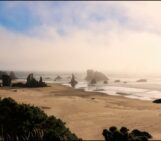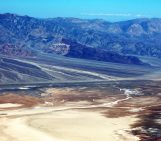This week in GeoTalk, we’re talking to Juan Carlos Afonso, a geophysicist from Macquarie University, Sydney. He explains how a holistic approach is crucial to understanding tectonic processes and how a little “LitMod philosophy” can go a long way to achieving this…
First, could you introduce yourself and tell us a little about what you are currently working on?
My name is Juan Carlos Afonso and I’m a geophysicist currently working at Macquarie University in Sydney, Australia. My research interests lie in the fields of geophysics and geodynamics, and span many different geophysical and geological processes. My current research integrates a lot of different disciplines, such as mineral physics, petrology, geodynamics, lithospheric modelling, nonlinear inversion, and physics of the mantle, to explore and improve our understanding of lithospheric evolution and plate tectonics.
More specifically, I am interested in the thermochemical structure and evolution of the lithospheric mantle, the mechanical and geochemical interactions between tectonic plates and the sublithospheric upper mantle, and their effects on small- and large-scale tectonic processes. The lithosphere is critical to humans because it is the reservoir of most of the natural resources on which modern society depends, as well as the locus of important geological and biological process such as seismic activity, CO2-recycling, mineralisation events, and volcanism!
During EGU 2012, you received a Division Outstanding Young Scientists Award for your research into the lithosphere and its properties. Could you tell us a bit more about your work in this area?
First of all, it was such a humbling experience to receive this award. I really admire the previous awardees and it is a real honour to have received this award.
I was selected for this award based mainly on the work I did on combining different geophysical and geochemical datasets into a single conceptual framework that has become known as the “LitMod approach”. This theoretical and computational framework fully integrates geochemistry, mineral physics, thermodynamics, and geophysics in an internally-consistent manner*. And allows researchers from different disciplines – seismology, geodynamics, petrology, mineral physics, etc. – to construct models of the Earth that not only satisfy one particular set of observations, but a multitude of observations. This is of primary importance because it guarantees consistency between theories and models (i.e. you can’t cheat!), and results in better and more robust data interrogation and interpretation. This approach is being applied to a wide range of geodynamic and geophysical problems, from studying the water content of the mantle to inferring the thermal structure of Venus.
More recently, my colleagues and I presented the idea of multi-observable probabilistic inversion, a technique that is similar to CAT-scanning in medicine, but that we used to study the thermochemical (or thermo-chemical-mechanical) structure of the lithosphere and upper mantle. We showed that it is a feasible, powerful and general method that makes the most out of available datasets and helps reconcile disparate observations and interpretations. This unifying framework brings researchers from diverse disciplines together under a unique holistic platform where everything is connected to everything else and it will hopefully help understand the workings of the Earth in a more complete manner. But there is a lot of work yet to be done to achieve this!!
How can programmes like LitMod help improve our understanding of plate tectonics?
A great scientist recently said “Each single discipline within the geosciences has progressed tremendously over the 20th century; the problems now lie at the interfaces between the sub-disciplines and ensuring that all geoscientific data are honoured in integrated models. We are well beyond the time when scientists can present their interpretations based on mono-discipline thinking. We absolutely must think of the Earth as a single physico-chemical system that we are all observing with different tools.” These sentences capture very well the spirit of the LitMod approach, which forces you to think about and interpret geoscientific data in a manner that ensures consistency (as much as possible!). I think one of the reasons for the interest in such an approach is the need for robust and easy-to-use tools that researchers from different disciplines can apply to their individual datasets (seismic, gravity, magnetotelluric, etc.) and explore the connections to other related datasets and disciplines – it helps researchers have a better understanding of the broader implications of their own models. It is also useful to petrologists interested in testing the geophysical and geodynamic implications of their petrological and geochemical models.
LitMod provides a platform wherein chemistry and physics are married such that models of lithosphere and sub-lithospheric mantle must be consistent with petrology, heat flow, topography, gravity, geoid, and seismic and electromagnetic observations. Too often we see models of the Earth, derived from a single dataset, that are incompatible with other observations. Some are better, some are worse. To have a model that explains all observations does not imply that the model is correct, but it does minimise the chances of being wrong! Plate tectonics and science in general use this concept to advance our knowledge of the Earth.
An important (if not the most important!) factor to mention here is that, as with any other project of this magnitude, LitMod would not be possible without the contribution of many scientists who unselfishly helped me to put things together. I’d like to thank Javier Fullea, James Connolly, Nick Rawlinson, Yingjie Yang, Alan Jones, Bill Griffin, Sue O’Reilly and Manel Fernandez for all their help and crucial input to the “LitMod philosophy”.
And importantly, how does it work?
The main idea is actually quite simple: a valid physicochemical model of the Earth has to explain all available data in a consistent manner. In essence, this is one of the main steps of the scientific method, right? The LitMod approach is simply a way of constructing Earth models (either by forward or inverse modelling) that satisfy basic physical principles and observations. In a nutshell, LitMod says “you cannot try to fit an observation by changing one parameter of your model without having to change all other parameters in a physically and thermodynamically consistent way, which in turn will affect the prediction of all the other observations”. This is a nice idea, and it should provide robust results as long as what one thinks is consistent, is actually correct. At this stage, we are confident with most of our choices, but there still is much work to do to get a complete understanding of how to model all available datasets simultaneously and how much we can believe our results.
The problem lies in the details, of course, because it is not easy to explain all data consistently when our understanding of each individual dataset is incomplete to different degrees. Moreover, the resolution and sensitivities of different datasets are markedly different too. This problem has a potential solution though. We just need to study the individual problems more carefully (e.g. more laboratory experiments, field case studies, etc.) until we obtain an understanding of them that is similar to the others. In practise this is not straightforward, and many gaps still exist in the description of some problems. A current example, but not the only one, is the discrepancy between results obtained by the magnetotelluric and seismic methods. But even in this case, an integrated modelling approach helps us to isolate the root causes of these discrepancies and to propose new studies to remediate them; something that could not be done by analysing the data separately.
And don’t forget the computational problems, which I find particularly fascinating and frustrating at the same time. Surprisingly, there is not much written about formal joint inversions of multiple datasets; we are learning as we go, but that is what keeps it entertaining!
Lastly, what are your research plans for the future?
I cannot know for sure what I’ll be doing in 10 years (probably geochemistry!), but I can tell you what I’m going to be doing in the next 5-6. Besides continuing working on regional scale inversions with LitMod, I am currently starting to work on two fronts that may appear disconnected at a first glance, but are actually intimately related. The first front is the construction of whole-Earth thermo-chemical-mechanical models, similar to what we are doing with LitMod, but at planetary scale. The other is modelling multiphase reactive flow in the Earth’s mantle with some new numerical techniques. In the end, 5-6 years from now, I think these two fronts will coalesce into a single thick wall… but noone knows whether the wall will stand solid or collapse like a castle of cards… we have to try though!
Want to know more about LitMod? Check out these resources:
Afonso, J. C. , Fullea, J., Griffin, W. L. , Yang, Y., Jones, A. G. , Connolly, J. A. D., O’Reilly, S. Y.: 3D multi-observable probabilistic inversion for the compositional and thermal structure of the lithosphere and upper mantle. I: a priori petrological information and geophysical observables. J. Geophys. Res., 118, 2586–2617, 2013.
Afonso, J. C., Fullea, J., Yang, Y., Connolly, J. A. D., Jones, A. G.: 3D multi-observable probabilistic inversion for the compositional and thermal structure of the lithosphere and upper mantle. II: General methodology and resolution analysis. J. Geophys. Res., 118, 1650–1676, 2013.
Fullea, J., Afonso, J. C., Connolly, J. A. D., Fernàndez, M., García-Castellanos, D., Zeyen, H.: LitMod3D: an interactive 3D software to model the thermal, compositional, density, rheological, and seismological structure of the lithosphere and sublithospheric mantle. Geochem. Geophys. Geosyst., 10, 2009.
*What is an internally consistent model?
By “internal consistency” I mean that all calculated parameters (e.g. thermal conductivity, bulk modulus, etc.) and observables (e.g. dispersion curves, travel times, et.c) are only and ultimately dependent on temperature, pressure, and composition (the fundamental independent variables), while being linked together by robust and sound (typically nonlinear) physical theories. This guarantees that a local change in properties (like density), which may be required to improve the fitting of a particular observable, will also be reflected in all other observables in a thermodynamically and physically consistent manner. It also implies that no linearity between observables needs to be assumed; each observable responds according to its own governing physical theory (e.g. sound propagation).
If you’d like to suggest a scientist for an interview, please contact Sara Mynott.






